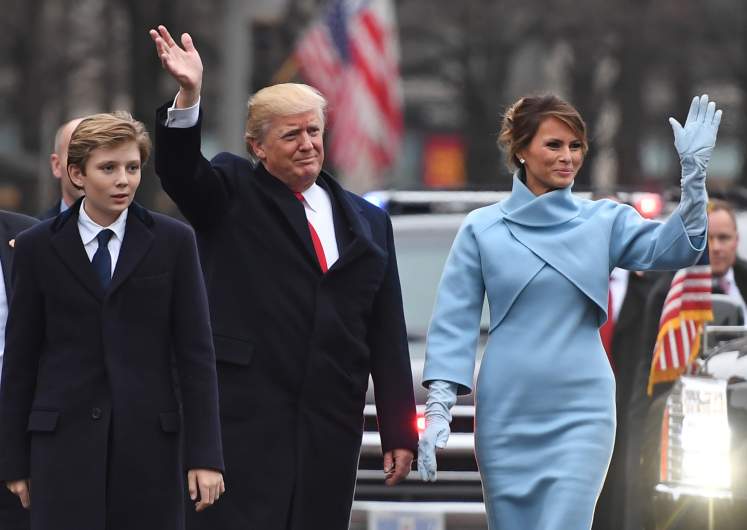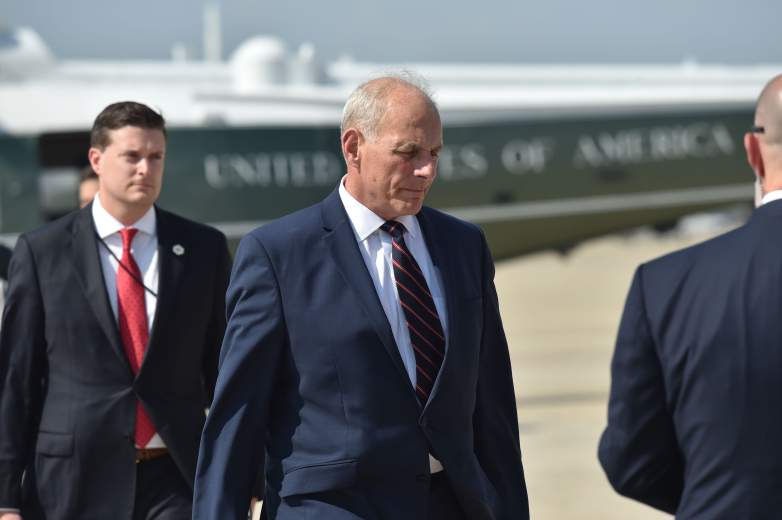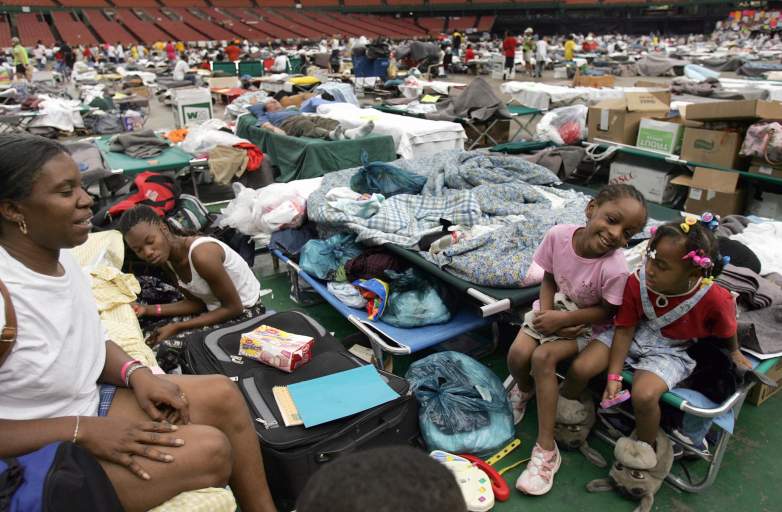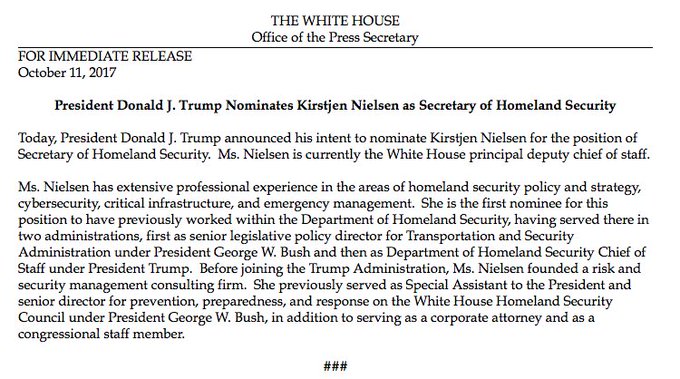https://twitter.com/10_gop/status/918239227942461442
President Donald Trump has nominated White House Deputy Chief of Staff Kirstjen Nielsen to replace John Kelly as the secretary of the Department of Homeland Security.
Nielsen had previously served as chief of staff at the department under Kelly, and followed him to the White House earlier this year after he was tapped by Trump to replace Reince Priebus as his chief of staff. Together, the two have been credited with restoring some order to the Oval Office after Trump’s turbulent first six months in office.
But while some have said that her previous experience in the White House and at the DHS will be an asset, others have expressed concerns about her past professional failures—including her involvement in the Bush administration’s refusal to prepare for Hurricane Katrina despite the repeated warnings from emergency officials.
Bennie G. Thompson, a ranking member of the House committee on homeland security, told Quartz that he worried that the department had not “learned all the lessons from that tragedy given what we are seeing unravel in Puerto Rico and the U.S. Virgin Islands.”
But a White House spokesperson said that Nielsen “understands the White House, has worked at the agency, and is prepared to step in on day one and get things done.”
Here’s what you need to know about Kirstjen Nielsen:
1. Nielsen Was a Homeland Security Advisor for George W. Bush, & Also Has Extensive Experience Working With the Government From Private Sector Consultancy Firms
Nielsen is a security expert who has worked in both the private and the public sectors. In 2003, she went to work for the Bush Administration as a homeland security advisor, and as the senior director for preparedness and response on the White House Security Council. In April 2007, Bush removed her from her position during a large staff turnover prompted by Congressional inquiries into the administration’s failure to heed warnings about the damage Hurricane Katrina would do to New Orleans.
A graduate of the University of Virginia School of Law, she had previously worked as a corporate lawyer in Dallas, Texas, and as the director of the Office of Legislative Policy in the Transportation Security Administration. After she left the White House in 2007, she served as president and general counsel for the Civitas Group, a national security firm, and on several councils for the World Economic Forum.
Nielsen went on to found Sunesis Consulting in 2012, a D.C.-based firm that “advises senior government officials and senior private sector officials on the development, assessment and execution of preparedness strategies, policies, plans, tools and tabletop exercises to prevent, protect against, respond to, and recover from all hazard events with a focus on cybersecurity, critical infrastructure and emergency preparedness and response.”
2. She Joined the Trump Administration the Day After He Was Inaugurated but Didn’t Officially Receive an Appointment Within the DHS Until April 2017

US President Donald Trump and First Lady Melania walk the inaugural parade route with son Barron on Pennsylvania Avenue in Washington, DC, on January 20, 2017 following swearing-in ceremonies on Capitol Hill earlier today.
After his inauguration in January 2017, Trump baffled the media by not immediately filling the many appointed cabinet positions that the president typically fills during his first months in office.
Instead, the president hired about 500 people to serve as temporary appointees as a stopgap until permanent appointments could be made. “The basic concept is a recognition that incoming administrations do not have the full confirmed team in place. How do you put people in to keep the agencies running?” president and CEO of Partnership for Public Service Max Stier told Politico.
According to a Newsweek exposé from March 2017, the temporary appointees had been “quietly installed … to serve as [Trump’s] eyes and ears at every major federal agency, from the Pentagon to the Department of Interior. Unlike appointees exposed to the scrutiny of the Senate, members of these so-called ‘beachhead team‘ have operated largely in the shadows, with the White House declining to publicly reveal their identities.”
Newsweek published a list of more than 400 individuals the publication had been able to identify as part of the “beachhead team,” including Kirstjen Nielsen.
Critics said that the beachhead teams were worrisome due to the closed-off nature of the hires, which filled positions that are normally subject to Senate confirmation. “If the public and Senate is in the dark about a team created without a Senate confirmation process, no one will be permitted to shed light on who is hopelessly conflicted or who is obviously unqualified and who is both,” director of the Revolving Door Project at the Center for Economic Policy and Research Jeff Hauser told Newsweek.
Nielsen’s position as chief of staff under John Kelly in the Department of Homeland Security was made permanent in April 2017. The position does not require Senate confirmation.
3. Nielsen Followed Former DHS Secretary John Kelly to the White House After Trump Tapped Him as Chief of Staff

GettyWhite House Chief of Staff John Kelly (C) walks to Air Force One on August 4, 2017, at Andrews Air Force Base in Maryland as US President Donald Trump travels on a 17-day vacation to Trump’s golf course in Bedminster, New Jersey. / AFP PHOTO / Nicholas Kamm
In July 2017, Trump announced that Chief of Staff Reince Priebus was the latest to be ousted from the White House, and that Secretary of Homeland Security John Kelly had been tapped as his replacement.
A former general in the U.S. Marine Corps, many close to the administration hoped that Kelly would bring much-needed structure and discipline to the White House by clamping down on the incessant leaks and perhaps reigning in some of the president’s more controversial comments.
Shortly after his transition into the position, Kelly announced that his former top deputy at Homeland Security, Kirstjen Nielsen, would join him at the White House as deputy chief of staff. The New York Times later ran an article about Nielsen’s appointment, calling her Kelly’s “enforcer,” and that the move equated to “installing a No. 2 who is willing to be hated.”
The Times added:
It is Ms. Nielsen who sends out the emails announcing internal policy and planning meetings that now contain a clipped addendum — “principals only” — with a stern warning that any subordinates who wander in will be immediately ejected.
She is also responsible for keeping Mr. Kelly’s no-fly list of aides he deems to be unfit to attend serious meetings, the most prominent of whom is Omarosa Manigault, the former “Apprentice” star with an ill-defined job and a penchant for dropping into meetings where she was not invited.
4. After Just a Month in the White House, Reports Surfaced That Nielsen Was Ruffling Feathers With Her No-Nonsense Style
In September, some top White House aides told Politico that Nielsen operated with an “us v. them” mentality that was ruffling feathers among the staff, earning her the nickname “Nurse Ratched.”
“Gatekeepers are generally not beloved,” said Jonathan Hoffman, whom Nielsen hired as the assistant secretary of public affairs back when she was at the Department of Homeland Security. “But that’s why it’s an important job.”
Politico said that Nielsen acts like the gatekeeper for Kelly in the same way Kelly has tried to act as a gatekeeper for Trump, shielding him from objectionable individuals by limiting their exposure to him with short meetings and terse email replies. The approach has caused frustration for some of Trump’s more hard-right advisors, who sense that Nielsen’s presence is a direct result of Kelly’s desire to weed out extremists who could damage the president’s public image.
Roger Stone, a chief strategist for Trump’s 2016 presidential campaign, added that at DHS, Nielsen “actively ensured that no Trump supporters were appointed or hired. … Like [national security adviser H.R.] McMaster and Kelly, she is a neocon who likely did not vote for Donald Trump and certainly does not support his non-interventionist worldview. If the president fails, it will be because of appointments like this.”
But others view the frustration with Nielsen as representative of the frequent staffing upheavals rather than a personality flaw or political maneuvering.
According to White House Press Secretary Sarah Sanders, “Kirstjen is a great addition to the White House and has been helpful in bringing fresh perspective and new structure to the team.”
“I don’t think she’s a political person by nature,” Frank Cilluffo, a colleague of Nielsen’s at George Washington University’s Center for Cyber & Homeland Security, told Politco. “She’s very competent and thoughtful. I’m not sure what the right training grounds are for anyone in these sorts of jobs, but she’s solid. She’s a wonk at heart, and she’s there to serve.”
5. Two Congressional Reports Named Nielsen as One of the Key Officials in the Bush Administration Responsible for the Failure to Heed Early Warnings About Hurricane Katrina

GettyKatrina evacuees at the Houston Astrodome in 2005.
When Hurricane Katrina devastated the city of New Orleans in 2005, Nielsen was officially serving as the director for preparedness and response on the White House Security Council. Following the disaster, Congress sought to investigate a series of failures on the part of the government that led to the unprecedented flooding.
A Senate report from 2006 entitled, “Hurricane Katrina: A Nation Still Unprepared,” discovered that Nielsen had received an email from FEMA officials in February 2005 warning that flooding in New Orleans “could cause similar devastation” as the 2004 tsunami that wreaked havoc on countries bordering the Indian Ocean and killed nearly 300,000 people.
The report, along with a similar report from the House, further indicated that the White House had failed to adequately prepare for the disaster despite repeated warnings from emergency officials about Hurricane Katrina’s strength and the inability of the levy system in New Orleans to handle the expected flooding:
Despite the clear warnings before landfall that Katrina would be catastrophic, the President and the White House staff were not sufficiently engaged and failed to initiate a sufficiently strong and proactive response. The White House’s – and the President’s – knowledge of the risk of a massive storm to New Orleans became even more specific in the days leading up to Hurricane Katrina. Katrina was a lesser challenge to the nation’s emergency-management apparatus than the 9/11 attacks in one critical way: It was preceded by 72 hours of increasingly dire predictions. In the days before landfall, the White House received repeated warnings from top officials at the National Weather Service and the National Hurricane Center that Katrina’s impact would be catastrophic.
Nielsen was among a number of those named as recipients of the many unheeded warning emails that flooded the Bush administration in the days leading up to Katrina’s landfall.
“Because the White House refused to cooperate with the Committee’s requests, we don’t know what the President and his staff did with the information about the impending disaster from Brown and others,” the report also noted.
Nearly 2,000 people were killed during the storm.

